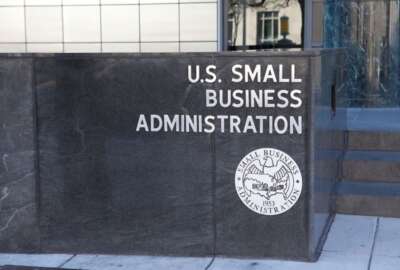SBA initiates ‘seismic shift’ in small business contracting
Federal procurement experts say applying the “rule of two” to all task order contracts is codification of the Tolliver decision by the Court of Federal Claims.
Nearly four years after the Court of Federal Claims issued its landmark Tolliver decision around the use of the small business “rule of two” for all contracting actions, including almost all task order type contracts, the Small Business Administration took the first step into putting this ruling into regulations.
SBA’s proposed rule, released on Oct. 25, would mandate agencies consider whether there are at least two qualified small businesses able to bid on a task or delivery order before issuing the procurement, and if there are, they would have to set it aside. While there are some exceptions to this proposed rule, including not having to apply the “rule of two” to schedule contracts run by the General Services Administration, federal procurement experts say the change would usher in a dramatic shift to small business contracting.
These former federal acquisition leaders disagree on whether the SBA’s proposal as written today would benefit or harm small businesses over the long term.
“This is potentially a seismic rule. It would completely change the face of multiple award contracts (MACs) overnight and I think not in a good way,” said Larry Allen, president of Allen Federal Partners and a federal procurement expert. “The intent of the rule is maybe positive to help small businesses, but I can’t help think that this is a proposed rule that essentially a cure in search of a problem.”
John Shoraka, co-founder and managing director of GovContractPros, an advisory services firm specializing in federal procurement and a former associate administrator of Government Contracting and Business Development at the SBA, offered the opposite view.
“Given the proliferation of governmentwide acquisition contracts (GWACs) and the consolidation of contracts, there has long been a concern about how multiple award contracts are impacting small businesses. So this helps small businesses and encourages more set asides,” he said. “Awards going to small businesses are going up, but the number of small business contractors are going down. This is, in part, a reaction to that. What measures can we implement to reverse that trend? I think we should probably look at the trajectory of all of these GWACs and the ability of small business to participate in that marketplace. Is it really conducive to small business participation? Should we look at that approach?”
Growth of MACs driving the change
SBA is accepting comments on the proposed rule through Dec. 24 and many experts expect a lot of small firms and other stakeholders to provide feedback.
Concerns about the shrinking small business industrial base as well as the increased use of GWACs and MACs are driving the differing opinions about the proposal.
In its proposed rule, SBA says agencies are missing out on awarding as much as $6.1 billion more to small firms if they had applied the rule of two to MACs and GWACs.

“The rule of two is the cornerstone of the federal government’s support for small-business prime contracting. In fiscal year (FY) 2023, set-aside awards accounted for 65% of contracting dollars awarded to small businesses, the highest percentage since data became available in 2010. Those set-aside dollars pushed the government’s spending with small business prime contractors to $178 billion in 2023, or 28.4%,” SBA wrote in its proposal. “This proposed rule would clarify the applicability of the rule of two to multiple-award contracts by directing that an agency set aside an order under a multiple-award contract for small business contract holders when the contracting officer determines there is a reasonable expectation of obtaining offers from two or more small business contract holders under the multiple award contract that are competitive in terms of market prices, quality, and delivery.”
SBA’s proposal implements an Office of Federal Procurement Policy memo from January telling agencies to apply the rule of two to MACs and document any decisions where this approach doesn’t work.
SBA’s decision to expand the use of the rule of two comes despite a record setting year for awards and total dollars. In fiscal 2023, SBA says agencies awarded an all-time high of 28.4% of all eligible federal contract dollars to small businesses for a total of $178.6 billion, which was an increase of $15.7 billion from 2022.
At the same time, data for 2023 from HigherGov, a market intelligence firm, show the use of multiple award contracts continued to grow. The company says almost 55.8% of all awards went through a contract vehicle with the General Services Administration’s OASIS and NASA’s SEWP V seeing record awards of $13.4 billion and $10.5 billion, respectively.
And add to all of this data the fact that the Biden administration is worried about the shrinking of the small business industrial base. OFPP’s supplier base dashboard shows 8,342 new small businesses worked in the federal market in 2023, up from 7,579 new entrants in 2022.
But at the same time, SBA said in 2022 that agencies since 2010 have seen about a 40% decrease in the number of small businesses receiving prime contract awards. Over the same period of time, the number of small companies doing business with the federal government for the first time has decreased by about 60% — and over the past 15 years, new entrants have dropped by approximately 80%.
‘Rule of two’ could cause more protests
Roger Waldron, the president of the Coalition for Government Procurement, said it’s unclear if this rule change will solve many of the challenges small businesses face.
“We support small businesses and want them to grow and succeed by reducing barriers in the marketplace, but this rule proposes a lot of unanswered questions about the impact of the overall system,” said Waldron, who hosts Off the Shelf on Federal News Network. “Will the proposed rule lead to more litigation concerning orders that are not set-aside and drive contracting officer to set aside orders when they otherwise would not, just to avoid litigation, increasing risks for agencies, taxpayers, and contractors? The statutory authority for order set-asides uses the word ‘may,’ clearly indicating discretion, which in my view was an intentional, conscious decision to shield these decisions from litigation. Agencies may decide not to solicit multiple award contracts that include both large and small businesses, and instead opt for separate and discrete set -aside and full and open multiple contracts for the same supplies or services. Because if there are small businesses on your contract, as an agency you have determined they can perform the full scope of work, so when will the order not be set aside?”
Allen also questioned whether this proposal would lead to more work for small businesses.
He said it’s unclear how the rule of two would both impact small business subcontractors as well as small firms who currently hold existing small business only GWACs and MACs like Polaris or VETS 2.
“If you look beyond the prime contractors, there contracts with sizable subcontracting requirements, some as much as 50% of all work must be subcontracted out to small businesses. So which types of small businesses are you trying to help?” Allen said. “The universe of businesses that could be primes or are you going to simultaneously hurt small businesses who can’t or aren’t primes by limiting subcontracting opportunities? It seems like SBA should be asked whether they are trying to rob Peter to pay Paul? If we want to be pro small business, let’s not pick winners and losers through acquisition regulations.”
Analysis should be done early in planning
Additionally, Allen said small and large businesses who invested hundreds of thousands of dollars or more to get on GWACs and MACs like OASIS+ or Alliant 2 or Polaris small business, may become far less attractive to federal contracting officers. Allen said it’s unclear if this rule would dilute the value of these contracts.
Shoraka, however, disagreed with that hypothesis. He said the SBA proposal more strongly emphasizes the need to apply the rule of two, which is something that contracting officers should already be doing.
“One challenge when I was in government was we’d argue before choosing a vehicle you should do the rule of two analysis. You can’t go to vehicle and say there aren’t any small businesses and not set-aside. So you should apply the rule of two analysis and then pick right vehicle, as opposed to gaming the system and avoiding the set aside requirement,” he said. “As small business advocate, I would certainly want rule of two analysis off the bat. To me, this is an even stronger codification of Tolliver the decision.”
Nicole Pottroff, a partner with the law firm of Koprince McCall Pottroff, said while statutorily SBA is on solid ground in extending the rule of two to MACs, she does expect the agency will receive a lot of positive and negative feedback.
“I think bit more definition of what an agency needs to do where there is no exception to the rule would be helpful. If they can’t apply the rule of two, it’s very vague right now about documenting and giving that to SBA,” she said. “If SBA gets a lot of feedback, that could be a powerful way to negotiate something in between. Right now, it’s not hard for contracting officers to justify not using the rule of two. It will be interesting to see how it all plays out.”
Copyright © 2025 Federal News Network. All rights reserved. This website is not intended for users located within the European Economic Area.
Jason Miller is executive editor of Federal News Network and directs news coverage on the people, policy and programs of the federal government.
Follow @jmillerWFED






